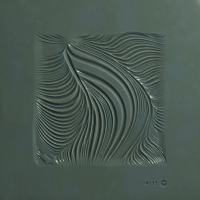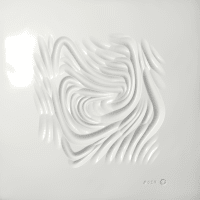Creating carved surfaces using three.js
How I achieved the 2D-to-3D textured surface effect in Ceramics, my first generative art NFT project.
My first NFT generative art project, released as part of Art Blocks’ Curated collection


I conceived of the idea for Ceramics in August 2021 while looking through the material archive boxes from my years studying jewellery and 3D design. I came across a square tile I’d made in a pottery class; it used a technique called sgraffito where a layer of coloured slip is added to a clay slab and carved into when it’s leather-hard, exposing the clay’s colour underneath. I’d carved an organic pattern into the tile, then filled in some of the lines with coloured underglaze.
I loved the feel of the tile, I was always running my fingers over it to stroke the subtle surface texture, and I was entranced by how many beautiful little details emerged from a quick, messy, unplanned doodle on a slice of clay.
Making things with my hands is my first love — I love the serendipity of physical processes and learning how to tame new materials, I love having an idea in my head and turning it into something I can touch and hold and take pride in.
Since speaking at Material Conference in 2018 I’ve been thinking about the web as a material. Like physical materials it has a unique set of properties that influence how you can work with it and what effects are easier or harder to achieve. The information space of the web is flexible and can feel limitless, but as a material for artistic production the visual output of screens is constrained - confined to a flat cartesian grid of red, green and blue. Unlike physical materials where perfection is unattainable (your line will never be straight, the colours will mix, the lighting won’t be quite right), screens lend themselves to order and they have to be forced to misbehave.
Mirroring artists like Piet Mondrian and Bridget Riley who employed minimalism and geometry in their physical work, Ceramics explores tactile and organic aesthetics in a digital space.
I want to emphasise the human influence on the outputs; I like to imagine a person creating each piece, carving meandering lines with hand tools. By humanising the creation process viewers can empathise with the decision-making the computer has to undertake to render each piece. To me, the beauty of these images is in recognising and appreciating all the tiny choices that come together to create each sumptuous composition.
Ceramics has ten distinct features that can be seen throughout the collection. Not all combinations of features are possible — for example mishima can only occur on thin and fine strokes.
The clay that forms the basis of the material. There are two stonewares, one earthenware, and one kaolin-based clay. Each clay has three states — raw (unfired), bisque fired, and fully fired with a glaze.
Glazed materials can have either a clear glaze or one of ten coloured glazes. Some glazes are thinner and allow the colour of the clay to be seen on the ridges between carve strokes.
The thickness of the strokes varies from fine to chunky. Thickness also influences the density of strokes.
The tool defines the profile of the implement used to carve the strokes. Some tools are more prevalent in thicker strokes, some in thinner.
Mishima is the ancient Korean technique of inlaying carved lines in pottery with a decorative slip or underglaze. In Ceramics this technique is sometimes applied to thin and fine strokes.
Placement defines the starting point of each carved stroke. Sometimes the patterns are subtle and almost invisible, other times it’s a defining feature of the composition. For all the placements except Chaos and Square the number of columns/rows is variable.
On each layer the starting point of each stroke remains in the same position but is oriented differently. Strokes intersect and overlap, in some outputs overwhelming the piece.
Density determines how much overlap the strokes can have. With Wild density there are no rules for how close the strokes can be to one another, often creating softer and more sculptural outputs.
This reflects the scale of the underlying flow field which controls the direction of the strokes. Micro results in condensed and tightly coiled compositions, where the strokes in Macro have more gradual changes in direction.
Most Ceramics pieces have a thick margin around the strokes but some have strokes bleeding right to the edge.
How I achieved the 2D-to-3D textured surface effect in Ceramics, my first generative art NFT project.
Exploring different forms of noise-based 2D vector fields and how to manipulate them.
How I used lighting, texture, and viscous glazes to make the surfaces in Ceramics feel real.
Using SVG and the Canvas API to draw custom typefaces and create hand-drawn effects.
Thanks to mrdoob for creating and maintaining three.js, Piter Pasma for his pseudo-random number generator script, Jon Cooper for help with writing, Mad, Sarah, Jordan, and everyone at Art Blocks for bringing this project to the platform, and Brian McNestry for being my enduring sounding board.